NRAO eNews
Volume Vol#, Issue Iss#
Day# Month# Year#
NRAO eNews
Volume Vol#, Issue Iss# • Day# Month# Year#

Upcoming Events
NRAO at the Seattle AAS | All times are PST.


New Eyes on the Universe: SKA & ngVLA Conference
May 1 - 5, 2023 | Vancouver, Canada

19th Synthesis Imaging Workshop
Jun 13 - 21, 2023 | Charlottesville, VA

The Evolution of Gas in and around Galaxies
Jul 31 - Aug 4, 2023 | Stanley, ID
Semester 2023A Proposal Outcomes

The NRAO has completed the Semester 2023A proposal review and time allocation process for the Very Large Array (VLA) and the Very Long Baseline Array (VLBA).
For the VLA the A and B-configurations will be available in the 23A semester and 180 new proposals were received by the 1 August 2022 submission deadline, including two large and twenty-seven time critical (triggered) proposals. The oversubscription rate (by proposal number) was 2.3 and the proposal pressure (hours requested over hours available) was 1.5, both of which are similar to recent semesters.
For the VLBA 45 new proposals were submitted. The oversubscription rate was 2.0 and the proposal pressure was 1.8, similar to past semesters.
There was some demand for the time made available on space observatories through inter-observatory agreements, and sixteen proposals requesting time on HST, Swift, Chandra, or XMM-Newton (together with AUI/NRAO telescope time) were submitted.
Proposals submitted to the GBO were assessed through the same process. Sixty-six proposals for the GBT were received for the 23A Semester. The oversubscription rate is 2.4 and the proposal pressure is 1.4. For information on proposals for GBT observations see the GBO website.
The proposals were reviewed for scientific merit by ten Science Review Panels (SRPs) and for technical feasibility by NRAO staff. These reviews were completed in August – September 2022 and then considered by the Time Allocation Committee (TAC) during a face-to-face meeting on 17-18 October 2022. The TAC – comprising the 10 SRP chairs – was charged with recommending a science program for Semester 2023A to the Observatory Director. The recommended program was reviewed and approved on 1 November 2022.
A disposition letter was sent to the Principal Investigator and Co-Investigators of each proposal on 7 November 2022 and a TAC report containing information for proposers and observers, including statistics and telescope pressure plots, was released the same day. The approved science program for the VLA and the VLBA has been posted to the NRAO science website. The authors, title, abstract, and scheduled hours for each approved proposal can be accessed from the Proposal Finder Tool.
The Student Observing Support program continues to be available for NRAO observing programs and we encourage Principal Investigators of highly ranked VLA and VLBA proposals to consider applying for support.
The NRAO welcomes community feedback on the proposal review and time allocation process. Please provide such feedback via the Proposal Review department of the NRAO Helpdesk
Joint VLA-ALMA Proposals to be Offered for Semester 2023B

The National Radio Astronomy Observatory (NRAO) and the Joint ALMA Observatory (JAO) are pleased to announce a Joint Proposal agreement between ALMA and the VLA starting in Semester 2023B and for ALMA Cycle 10. The Joint Proposal opportunity takes advantage of the many scientific synergies between these unique interferometric facilities as well as taking advantage of “full sky” coverage with facilities in the northern and southern hemispheres.
NRAO will offer joint VLA-ALMA proposals for the upcoming 23B semester with a proposal deadline of 01 February 2023. By agreement with the ALMA Observatory, NRAO may award a maximum of 50 hours of ALMA observing time on each array to Joint Proposals per cycle. Similarly, ALMA will be able to allocate up to 5% of the available time per year on the VLA starting with the ALMA Cycle 10 Call for Proposals.
It is anticipated that for the upcoming calls for proposals, VLA proposers will be able to propose for ALMA 12-m configurations C1 through C8 as well as the 7-m and TP arrays. Similarly, VLA configurations D, C and B will be available for Joint Proposals. Proposers need only to submit one (1) proposal at either the VLA or ALMA calls to take advantage of this opportunity. It is also important that the scientific need utilizing both facilities is well justified.
More details on how to apply for VLA-ALMA Joint Proposals will be provided in future announcements by both Observatories. Any questions on Joint Proposals can be directed to the NRAO or ALMA Helpdesks.
Design Review for ngVLA Antenna Clears Way for Prototype Construction
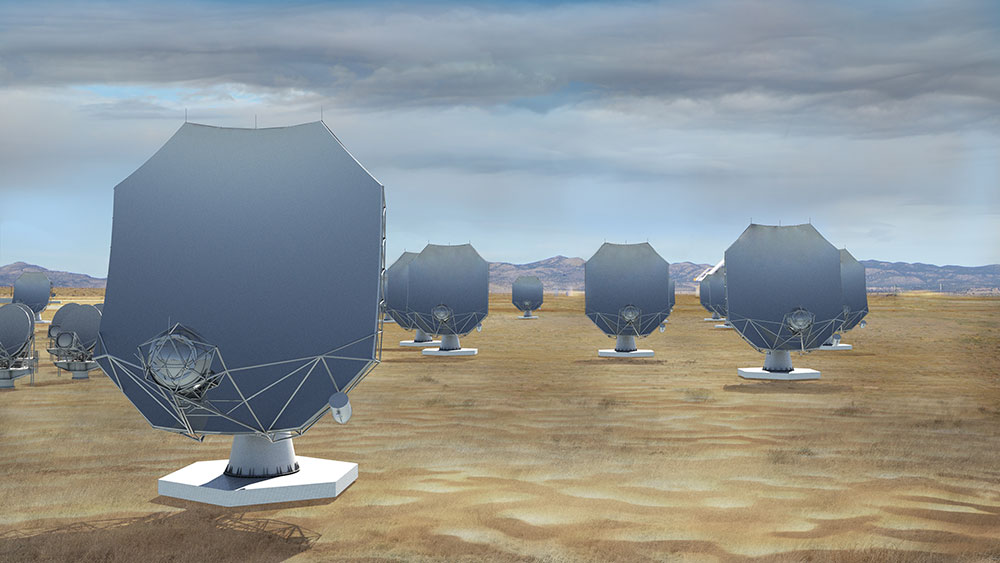
Prototype ngVLA antennas
[click to enlarge]
The design for the Next Generation Very Large Array (ngVLA) prototype antenna has passed an intensive, five-day review, clearing the way to begin manufacturing the prototype antenna. The review in Wiesbaden, Germany was attended by scientists and engineers from the National Science Foundation (NSF), the NSF's National Radio Astronomy Observatory (NRAO), and mtex antenna technology GmbH, the firm contracted to develop the design and produce the prototype. The NRAO and mtex representatives presented details of the design to a panel of experts -- coming from U.S. and South African institutions -- independent of the project.
The review panel's report recommended that the project proceed to manufacturing the prototype antenna. They concluded that the design fulfills ngVLA requirements and is mature enough to be manufactured. While they noted some items that need additional work, they said those items are minor and do not require further external review. The panel also noted the "good, healthy, open and honest working relationship between mtex and NRAO."
"The antennas are a key element of the ngVLA, and their performance is vital to the success of the entire system. I congratulate the NRAO-mtex team on this important milestone in their development," said NRAO Director Tony Beasley.
The ngVLA, a powerful radio telescope with 263 dish antennas distributed across North America, is proposed as one of the next generation of cutting-edge astronomical observatories designed to meet the leading research challenges of the coming decades. It will have sensitivity to detect faint objects and resolving power more than 10 times greater than the current VLA.
NRAO and mtex signed a contract in mid-2021 for design of 244, 18-meter diameter antennas and production of a prototype. An additional 19, 6-meter antennas are not part of this contract. Based on NRAO specifications and a conceptual design study, NRAO and mtex have worked intensively to refine the design's details to a level that allows prototype manufacturing to begin. The project is funded by the NSF.
The prototype will be manufactured by pre-selected suppliers and initially tested in 2023. In early 2024, it will be shipped to the VLA site in New Mexico. The prototype will undergo extensive testing before being integrated into the current VLA. After including any refinements arising from the final round of testing, the design will be ready for mass production, for which a separate contract will be awarded.
"This review confirmed that our colleagues at mtex clearly understand our needs for high quality and performance and also the requirement that the design can be manufactured cost effectively in the numbers needed," said NRAO's ngVLA Project Engineer Rob Selina.
Relativistic Ejecta in Broad-lined Type Ic Supernovae
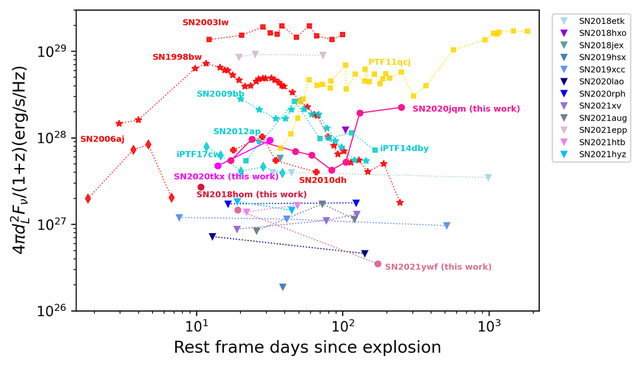
Shades of pink, purple and blue show light curves at 6 GHz of our Ic-BL SNe. Downward-pointing triangles mark non-detections. Filled circles mark detections. Other colors allow comparisons with other SNe. Credit: Corsi et al. (2022).
[click to enlarge]
Stripped-envelope core-collapse supernovae (SNe) with high photospheric velocities (Ic-BL) are rare and energetic stellar explosions that challenge the standard explosion mechanism of massive stars. SNe Ic-BL are the only type of core-collapse events unambiguously linked to gamma-ray bursts (GRBs; Woosley & Bloom 2006). However, not all SNe Ic-BL make GRBs and the reason behind this remains a mystery.
Radio follow-up observations of SNe Ic-BL can probe the explosions’ fastest-moving ejecta largely free of geometry and viewing angle constraints that affect observations in gamma-rays. Measuring the fraction of SNe Ic-BL that output relativistic jets, and their kinetic energy via radio calorimetry, can directly test the predictions of GRB-SN progenitor and explosion models.
Motivated by the above, Corsi et al. (2022) conducted a search for relativistic explosions in a sample of 16 SNe Ic-BL observed with the Zwicky Transient Facility (Bellm et al. 2019), and discovered independently of a gamma-ray trigger. This campaign, carried out using the Jansky VLA, doubled the sample previously presented in Corsi et al. (2016). Our results show that SNe Ic-BL like the GRB-associated SN 1998bw, SN 2003lw, SN 2010dh, or the relativistic SN 2009bb and iPTF17cw are intrinsically rare (see figure). However, the parameter space of SN 2006aj-like events (faint and fast-peaking radio emission; Soderberg et al. 2006) is left largely unconstrained, and systematically exploring it represents a promising line of future research.
The Legacy Survey of Space and Time on the Vera Rubin Observatory (Ivezic et al. 2019) will provide numerous discoveries of even the rarest type of explosive transients, such as the SNe Ic-BL discussed here. Recognizing them early (e.g., Villar et al. 2020), and enabling their prompt radio follow-up with the ngVLA (Murphy 2018), could provide a unique opportunity for building a large statistical sample of SNe Ic-BL with deep radio observations. This sample could guide theoretical modeling in a more systematic fashion, beyond what has been achievable over the last 25 years.
Since 2015 the acronym ngVLA has appeared in 900+ publications indexed in the SAO/NASA Astrophysics Data System. This article continues a regular feature intended to showcase some of those publications. We are especially interested in showcasing work done by early-career researchers. The collection of showcase articles can be viewed online. Anyone wishing to volunteer to author a feature should contact Joan Wrobel.
ALMA Program News
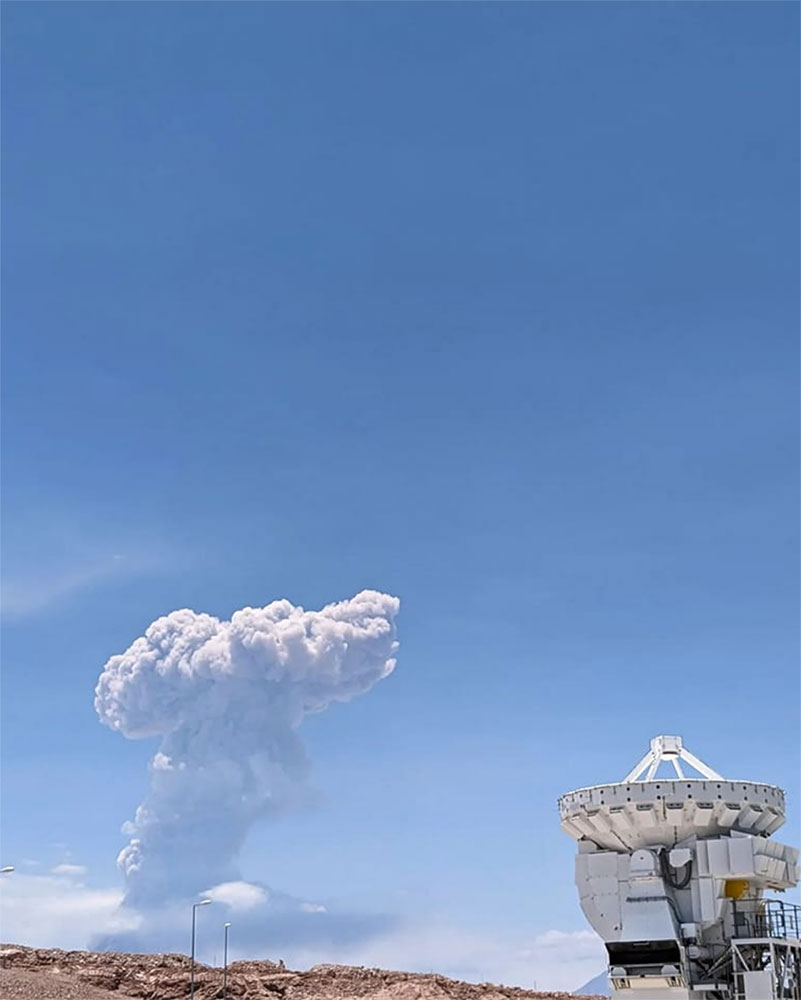
María Jesús López, ALMA photo-ambassador
The volcanic eruption of Lascar, pictured in the background of this recent photo, poses no threat to ALMA.
[click to enlarge]
ALMA Cycle 9
ALMA is in compact configurations. Cycle 9 data acquisition began 30 September 2022. The Joint ALMA Observatory is pleased to announce that ALMA has resumed performing PI science observations following the cyberattack. The end-to-end data acquisition and processing workflow and software were successfully re-tested prior to the restart. ALMA is currently taking observations in configuration C-3. User services are also now back online, including access to ALMA user profiles, SnooPI, and the Cycle 9 Director’s Discretionary Time submission server.
As previously announced, ALMA’s most compact configurations (C-1 and C-2) will not be visited again in Cycle 9. Some Scheduling Blocks (SBs) requiring configuration C-2 were already observed in the days prior to the cyberattack. Projects with SBs in nominal configurations C-1 and C-2 that can still be observed in configuration C-3 will remain in the observing queue. As per usual ALMA policy, incomplete Cycle 9 Grade A projects will carry over into Cycle 10.
Regarding Cycle 10, due to the disruption caused by the cyberattack, the Cycle 10 pre-announcement will now be issued in the week of January 16.
American Astronomical Society (AAS) Meeting 141 Special Session
A Special Session titled ALMA Status and Plans for Increased Capability has been scheduled for the January 2023 American Astronomical Society (AAS) meeting in Seattle, Washington. This Special Session will take place on Monday 9 January from 2:00-3:30 pm PST in Ballroom 6 at the Convention Center. A new paper describing the upgrade is available. (See Carpenter, Brogan, Iono, & Mroczkowski (2022), The ALMA2030 Wideband Sensitivity Upgrade, ALMA Memo 621; arXiv:2211.00195).
2nd Announcement: The Evolution of Gas in and around Galaxies
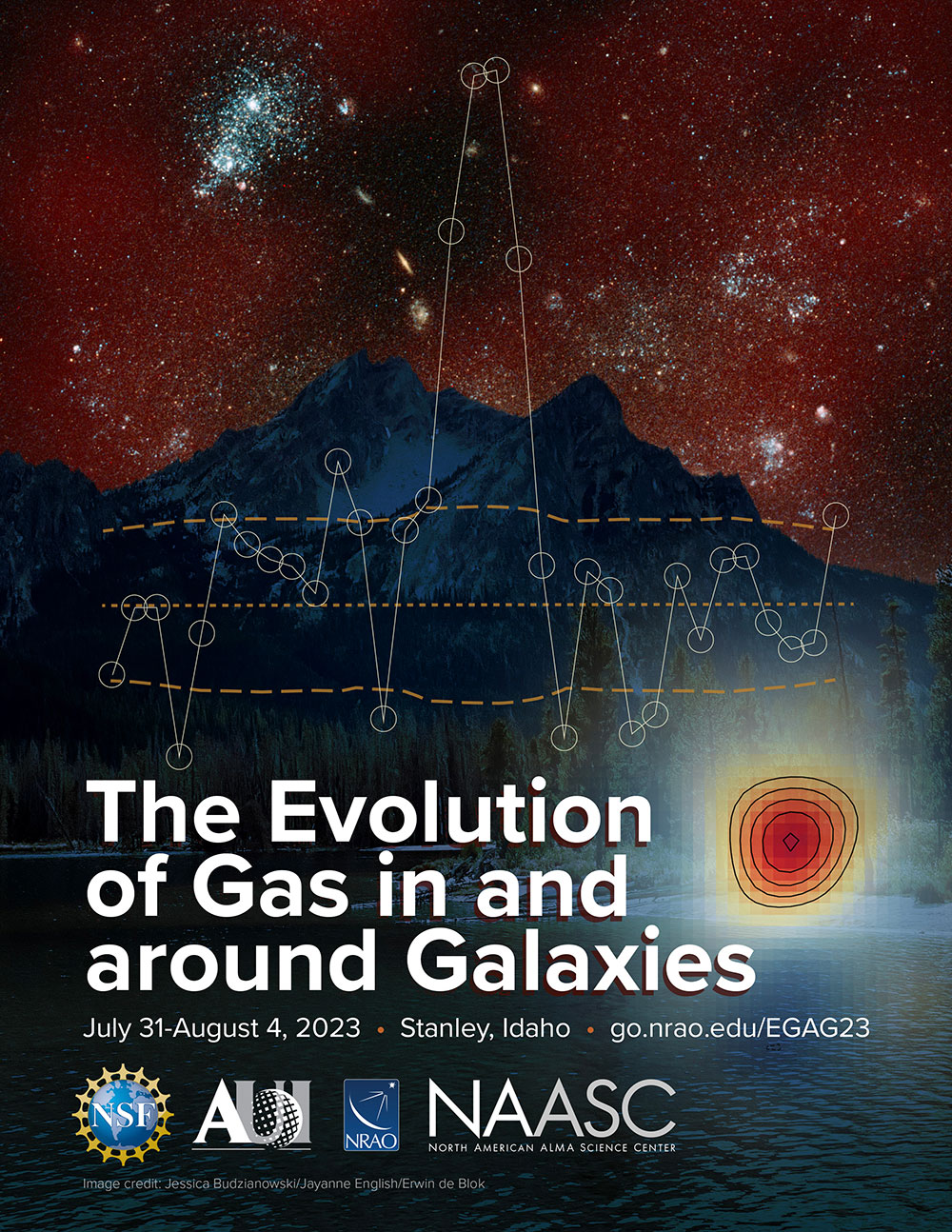
[click to enlarge]
We invite you to consider the conference "The Evolution of Gas in and around Galaxies", which will take place 31 July to 4 August 2023, in the dark sky reserve of beautiful Stanley, Idaho, USA. The goal of the conference is to compare and contrast the results of new HI 21cm, C+, and circumgalactic medium studies, made possible by the advent of a range of new telescopes, to compare them to theoretical predictions, and to place the new results in the context of galaxy evolution. Please see the meeting website for more details about the meeting.
Space for this meeting is limited to 60 participants due to venue constraints and a desire to keep discussions focused and lively. We aim to balance attendance between students, early-, mid-, and late-career astronomers, bringing together a diversity of experience, backgrounds, and interests. To help us achieve this balance, we request that all applicants complete an Expression of Interest, briefly describing their reasons for wishing to attend the meeting. The organizing committee has just begun to review the Expressions of Interest, and will continue either until 31 January 2023, or until all available spaces are filled. Applicants would be invited to register, based on this review process. We emphasize that registration will be invitation-only. We encourage all interested participants to complete their Expression of Interest as early as possible, as spaces may fill quickly.
The VLA Low-band Ionosphere and Transient Experiment (VLITE)
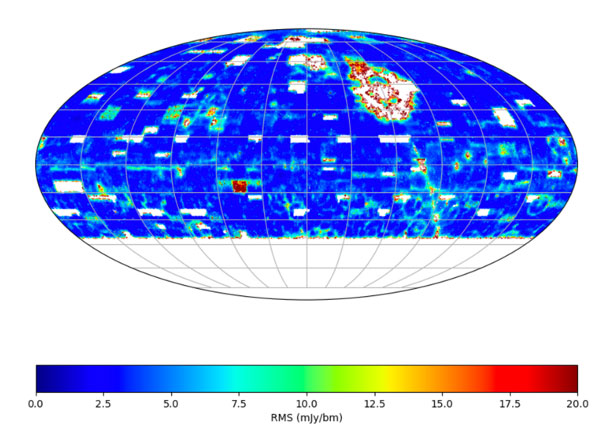
VCSS1 sky coverage plot
[click to enlarge]
Scientific exploration continues with the Very Large Array (VLA) Low-band Ionosphere and Transient Experiment (VLITE), a commensal 340 MHz primary focus system that operates simultaneously with nearly all VLA Cassegrain receiver observations. VLITE’s DiFX correlator operates in parallel to WIDAR, providing simultaneous wide field of view, low frequency coverage of each VLA field. On 25 November 2022, VLITE turned eight years old and has progressed from a test system with 10 antennas to the current stable 18 antenna system that correlates both standard sidereal tracking observations as well as those observations taken in the on-the-fly mode used by the VLA Sky Survey (VLASS). During a typical year, VLITE records over 6000 hours of data that are pipeline processed and cataloged at the Naval Research Laboratory (NRL).
A key recent milestone is the measurement of a 2D primary beam response for VLITE that is applicable to the different observing bands. Using this beam model, VLITE data, including those associated with VLASS, can now be accurately corrected for the offset and rotating primary beam response. We have released the VLITE Commensal Sky Survey (VCSS) Epoch 1 Bright Source Catalog through collaboration with CIRADA. This catalog contains sources detected above 50 sigma (~150 mJy/beam, 10” < beam < 30”) from observations recorded in parallel with the first epoch of VLASS data. The figure illustrates the VCSS1 sky coverage plot. Colors correspond to local RMS noise values near cataloged sources. The average 1σ noise is 3 mJy bm−1. The small higher-noise tiles (e.g. RA ∼ 3 hrs, Dec ∼ −12o) are likely the result of gain errors in the primary calibration. The Galactic Plane is clearly visible, as are areas of increased noise when bright sources such as Cyg A and Cas A are in the primary beam sidelobes. White squares above the Dec -40° survey cutoff are regions where no VCSS1 images are available.
VLITE data has been used or cited in 44 refereed papers covering a diverse range of science from tidal disruption events and fast radio bursts to studies of active galactic nuclei and distant quasars. We would like to thank all the present and former NRAO staff and scientists who have made these milestones possible.
Dave Finley to retire from NRAO after 30 years
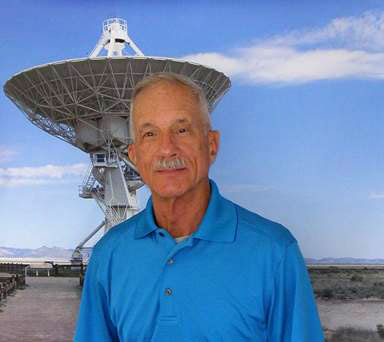
Following more than 30 years of service, Dave Finley will retire as NRAO's Public Information Officer for New Mexico on 20 January 2023. Dave was the first public information officer at the Very Large Array (VLA), and over the past three decades, has helped launch hundreds of scientific research projects into the public spotlight. Dave's expertise has elevated important and historic moments in radio astronomy such as the launch of the NVSS survey, the first measurement of the speed of gravity, and the discovery of the precise location of a Fast Radio Burst (FRB). In addition to clear explanations of scientific breakthroughs, he has shepherded communications for the Very Large Array through exciting projects like the filming of Contact, fashion and car commercials, rock videos, and accurate messaging in more serious times, including the Covid pandemic. He has represented the interests of the Observatory and the VLA and Very Long Baseline Array (VLBA) to state, local, and federal government, helping to elevate our facilities, our positive economic impact in New Mexico, and the hard work of scientists around the world.
VLA & VLBA Press Release Requests
As of December 2022, please direct all requests for press releases for the Very Large Array and Very Long Baseline Array to:
Amy C. Oliver
Public Information & News Manager, NRAO
aoliver@nrao.edu
Recent Media Releases
|
ALMA Has Successfully Restarted Observations |
|
|
VLA and ALMA Study Jupiter and Io |
|
|
Silent as the Night: Why Radio Astronomy Doesn't Listen to the Sky |
From the Archives
Ellen Bouton

[click to enlarge]
About this month's photo: In November 1981, scientists gathered in Green Bank for a workshop on Extragalactic Molecules, one of the series of NRAO workshops held in Green Bank in the 1980s. We have only a handful of identifications of the attendees in this photo: [Front] Paul Ho, 4th from left; Riccardo Giovanelli, 6th from left; Frank Kerr, 8th from right; Ernie Seaquist, 7th from right; Barry Turner, 5th from right; Jay Lockman, 2nd from right. [Back] Lee J. Rickard, 2nd from left; Renzo Sancisi, 3rd from left; John Dickey, 8th from left; Martha Haynes, 2nd from right; Bob Havlen, 1st on right. Were you there? Can you identify others in the photo? Please contact Ellen Bouton if you are able to add names.
From the Archives is an ongoing series illustrating NRAO and U.S. radio astronomy history via images selected from our collections of individuals' and institutional papers. If readers have images they believe would be of interest to the Archives, please contact Ellen Bouton.

